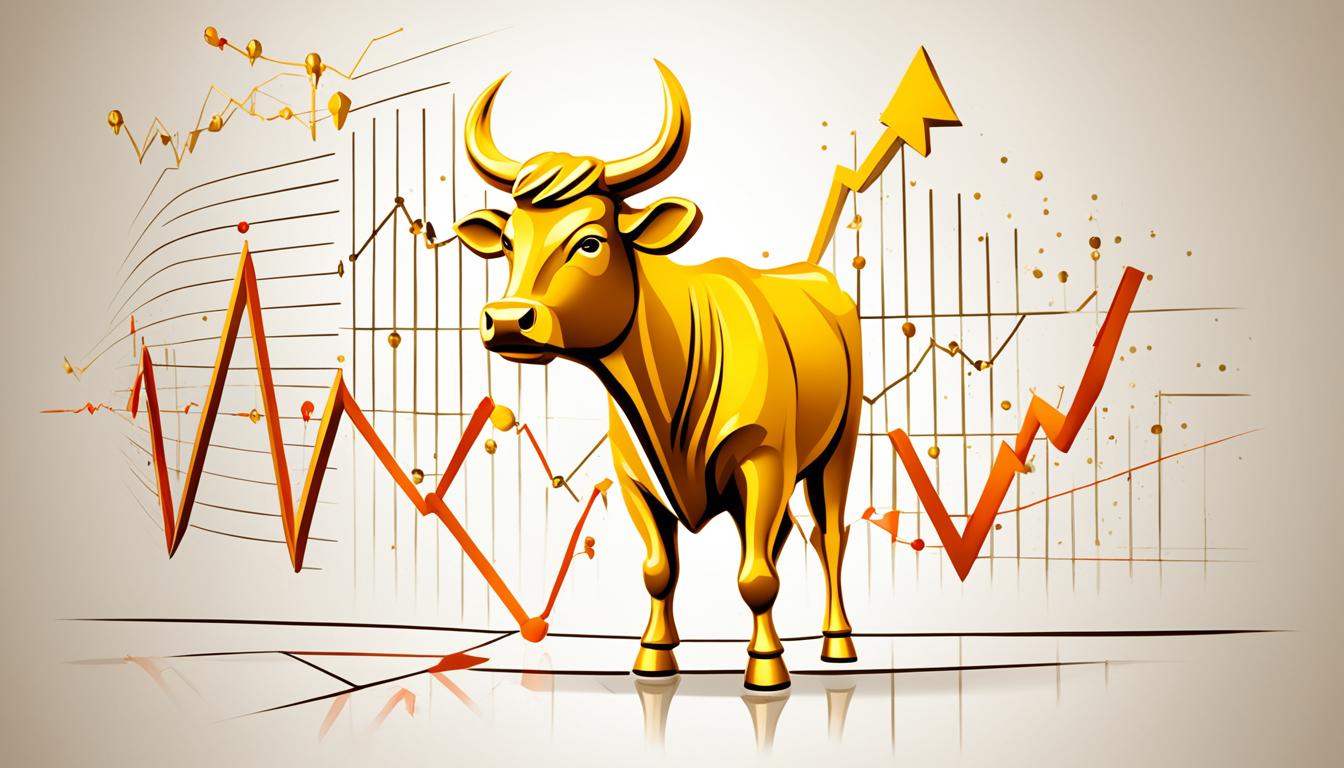When it comes to navigating the stock market, analyzing trends and indicators is crucial for success. One such powerful technical indicator is the Golden Cross. In this article, I will delve into the concept of Golden Cross, its significance in technical analysis, and how it can be used as a strategic tool in stock trading.
The Golden Cross refers to a bullish signal that occurs when a short-term moving average, typically the 50-day moving average, crosses above a long-term moving average, usually the 200-day moving average or a resistance level. This price crossover is seen as a significant trend reversal and is considered a reliable indicator for a potential long-term bull market.
Traders and investors often utilize moving averages in their technical analysis to smoothen out price fluctuations and identify trend changes. The Golden Cross acts as a confirmation of a bullish breakout pattern, indicating a shift from a downward trend to an upward one. This technical indicator becomes more reliable when accompanied by high trading volumes, reinforcing the bullish sentiment.
Key Takeaways:
- The Golden Cross is a bullish signal and a significant trend reversal indicator in stock trading.
- It occurs when a short-term moving average crosses above a long-term moving average or resistance level.
- The 50-day moving average and the 200-day moving average are commonly used in Golden Cross analysis.
- A Golden Cross is considered reliable when accompanied by high trading volumes.
- Traders use Golden Cross in combination with other indicators and risk management strategies to make informed trading decisions.
What Is a Golden Cross?
A golden cross is a chart pattern that occurs when a stock’s short-term moving average crosses above its long-term moving average. This pattern indicates the potential for a major rally in the stock market. The short-term moving average is usually the 50-day moving average, while the long-term moving average is typically the 200-day moving average. The golden cross is a bullish breakout pattern that confirms a trend reversal from a downward trend to an upward one. It is often accompanied by high trading volumes, which further reinforce the bullish signal.
When a stock’s short-term moving average crosses above its long-term moving average, it represents a crossover point where positive momentum is gained. This crossover is known as a golden cross and is considered a strong bullish signal by technical analysts. It suggests that the stock’s price is likely to continue rising in the future.
| Date | Stock Price | 50-day Moving Average | 200-day Moving Average |
|---|---|---|---|
| Jan 1 | 50 | – | – |
| Jan 2 | 55 | – | – |
| Jan 3 | 58 | – | – |
| Jan 4 | 62 | – | – |
| Jan 5 | 60 | – | – |
| Jan 6 | 65 | 58 | – |
| Jan 7 | 68 | 60 | – |
| Jan 8 | 70 | 62 | – |
| Jan 9 | 75 | 64 | – |
| Jan 10 | 80 | 66 | 60 |
In the example above, the stock’s price consistently rises, eventually leading to a golden cross. On January 10, the stock’s short-term moving average (50-day) crosses above its long-term moving average (200-day), signifying the golden cross. This pattern confirms the reversal from a downward trend to an upward one, indicating a potential long-term bull market. The presence of the golden cross suggests that the stock’s price is likely to continue increasing.
Overall, the golden cross is a significant chart pattern in technical analysis, providing traders and investors with valuable insights into potential bullish opportunities in the stock market.
How Does a Golden Cross Form?
A golden cross is formed through a series of stages. First, a downtrend reaches a bottom as buyers overpower sellers. Then, the shorter moving average crosses over the larger moving average, triggering a breakout and confirming a downward trend reversal. This crossover occurs when the price crosses a resistance level or support level. Finally, a continuing uptrend occurs, and the moving averages act as support levels on pullbacks until they cross back down. In the golden cross, the most commonly used moving averages are the 50-day and 200-day moving averages, although traders may use different periodic increments based on their preferences and trading strategies.
Let’s take a closer look at the stages of a golden cross formation:
- The downtrend bottom: In a downtrend, sellers dominate the market as prices decline. Eventually, buyers step in and overpower the sellers, leading to a bottom in the trend.
- The crossover: After the downtrend bottom, the shorter moving average, such as the 50-day moving average, begins to rise. As it crosses over the larger moving average, typically the 200-day moving average, a breakout occurs, signaling a trend reversal.
- The resistance level: The price of the stock or asset crosses a resistance level, which confirms the breakout and the formation of a golden cross. This resistance level acts as a key threshold that the price needs to surpass to establish a bullish trend.
- The support level: As the golden cross forms, the moving averages act as support levels on any pullbacks in the price. Traders often use these levels as potential entry points to ride the upward trend.
- The continuation of the uptrend: The golden cross confirms a reversal from a downward trend to an upward one. The moving averages support the upward price movement, with the shorter moving average staying above the longer moving average. However, it’s important to note that the golden cross is not a guarantee of a sustained uptrend, and careful analysis and risk management should be employed.
Below is an image depicting the stages of a golden cross formation:
The Difference Between a Golden Cross and a Death Cross
A golden cross and a death cross are contrasting indicators that provide valuable insights into market trends. Understanding the distinctions between these two patterns can help traders make informed investment decisions.
An essential difference lies in the market conditions that each cross represents. A golden cross signifies a long-term bull market, which suggests an upward trend and optimistic sentiment among investors. Conversely, a death cross indicates a long-term bear market, signaling a downward trend and a pessimistic outlook.
The formation of a golden cross occurs when a short-term moving average, such as the 50-day moving average, surpasses the long-term moving average, typically the 200-day moving average. As this crossover takes place, the long-term moving average transforms into a support level. In contrast, a death cross forms when the short-term moving average crosses below the long-term moving average, causing the latter to become a resistance level.
Both crosses can be considered as potential trend-change signals. However, their reliability is enhanced when accompanied by high trading volumes. Therefore, traders and investors should closely monitor volume fluctuations when analyzing these patterns.
Let’s compare the characteristics of a golden cross and a death cross using a table:
Golden Cross |
Death Cross |
|---|---|
| Confirms a long-term bull market | Signals a long-term bear market |
| Short-term moving average crosses above long-term moving average | Short-term moving average crosses below long-term moving average |
| Long-term moving average becomes support | Long-term moving average becomes resistance |
| Accompanied by high trading volumes | Accompanied by high trading volumes |
By understanding the nuances of a golden cross and a death cross, traders can employ technical analysis to better comprehend the implications of these patterns. However, it is prudent to use these indicators in conjunction with other technical tools and risk management strategies to make informed trading decisions.
Example of a Golden Cross
An example of a golden cross can be seen in the image below, which shows the 50-day and 200-day moving averages. The golden cross forms when the shorter 50-day moving average trend rises above the longer 200-day moving average, confirming a reversal from a downward trend to an upward one. In this example, the candlestick’s price range makes a significant jump when the downward trend bottoms out and turns into an uptrend. This indicates a change in investor and trader market sentiments, and the days close with prices much higher than the opening during the first uptick after the 50-day moving average bottoms.
Conclusion
The golden cross is a powerful technical indicator in the stock market that can signal a potential trend reversal and the emergence of a long-term bull market. When a stock’s short-term moving average crosses above its long-term moving average or resistance level, it forms a golden cross, which serves as a reliable bullish signal for traders and investors. However, it is important to note that the golden cross should not be used in isolation but rather in combination with other indicators and risk management strategies.
By utilizing the golden cross, traders and investors can identify optimal entry and exit points in the stock market, ensuring they take advantage of potential upward price movements. The confirmation of a trend reversal from a downward to an upward trend can provide valuable opportunities for profit. Alongside technical analysis and moving averages, incorporating the golden cross into investment strategies can enhance decision-making processes and increase the chances of successful trades.
As with any trading strategy, risk management is crucial. While the golden cross can provide a strong bullish signal, it is essential to consider other factors such as market conditions, volatility, and fundamental analysis. By combining various indicators and taking a comprehensive approach to technical analysis, traders can make more informed decisions and mitigate potential risks.


